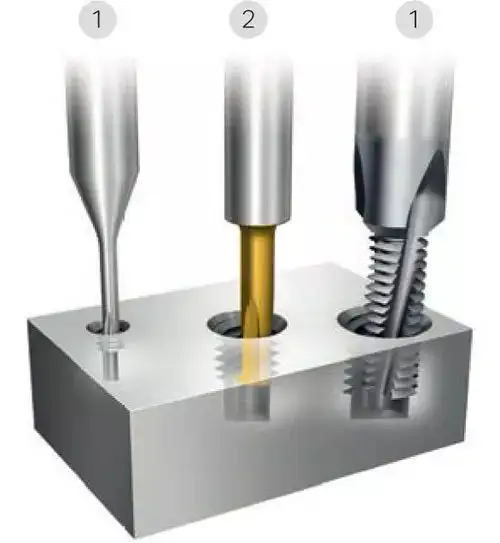1 Characteristics of thread milling
Thread milling is a milling method that uses a thread milling tool, a three-axis linkage of the machining center, i.e., X and Y-axis circular interpolation, and Z-axis linear feed, to process threads.
Thread milling is mainly used to process threads of large holes and threaded holes of difficult to machine materials. It has the following main features.
(1) Fast processing speed, high efficiency and high machining accuracy in machining plant. The tool material is usually carbide material, and the tool travel speed is fast. The manufacturing accuracy of the tool is high, so the threads milled are highly accurate.
(2) The milling tool has a wide range of application. As long as the pitch is the same, a tool can be used for both left-hand thread and right-hand thread, which is conducive to reducing tooling costs.
It is especially suitable for thread processing of difficult materials such as aluminum, copper, stainless steel, etc. It is especially suitable for thread processing of large parts and parts of precious materials, which can ensure the quality of thread processing and the safety of the workpiece.
(4) Because there is no tool front guide, it is suitable for processing blind holes with short thread bottom holes and holes without receding slots.
2 Classification of thread milling tools for machining plants
Thread milling tools can be divided into two types, one is the machine clamped carbide insert milling cutter and the other is the integral carbide milling cutter. The machine-clamped cutter has a wide range of application and can process both holes with thread depth less than the length of the insert and holes with thread depth greater than the length of the insert. Integral carbide milling cutters are generally used to machine holes with thread depths less than the length of the tool.
3 CNC programming of thread milling in machining plant
The programming of thread milling tools is different from that of other tools. If the machining program is prepared incorrectly, it is easy to cause damage to the tool or wrong thread machining. The following points should be noted when programming.
(1) The bottom hole of the thread should be machined first. A drill should be used for small diameter holes, and boring should be used for larger holes to ensure the accuracy of the bottom hole of the thread.
(2) The tool cutting in and out should use circular trajectory, usually 1/2 turn for cutting in or out, while the Z-axis direction should travel 1/2 pitch to ensure the thread shape. The tool radius compensation value should be brought in at this time.
(3) One week of X and Y-axis circular interpolation, the spindle should travel one pitch along the Z-axis direction, otherwise, it will cause the threads to buckle.
(4) Specific example procedure: The thread milling tool diameter is Φ16, the threaded hole is M48×1.5, and the threaded hole depth is 14.
The machining procedure is as follows.
(The threaded bottom hole procedure is omitted, the hole should be taken to bore the bottom hole)
G0 G90 G54 X0 Y0
G0 Z10 M3 S1400 M8
G0 Z-14.75 Advance to the deepest part of the thread
G01 G41 X-16 Y0 F2000 Move to the feed position and add radius compensation
G03 X24 Y0 Z-14 I20 J0 F500 Cut in 1/2 turn arc cut
G03 X24 Y0 Z0 I-24 J0 F400 Cutting the entire thread
G03 X-16 Y0 Z0.75 I-20 J0 F500 Cut out with 1/2 turn circle G01 G40 X0 Y0 Back to center, no radius compensation
G0 Z100
M30













